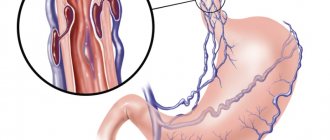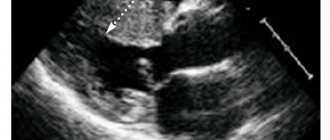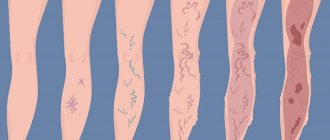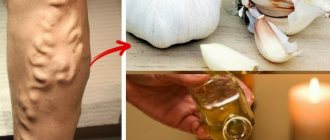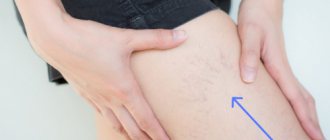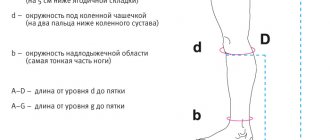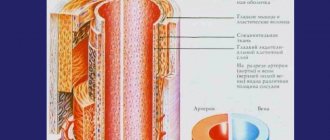Such a serious and painful disease as varicose veins on the inside and outside of the knee occurs in 10 percent of the population.
The occurrence of varicose veins in this area of the lower extremities may be due to its low location relative to the body, and therefore there is an increased load on this area.
If the patient constantly feels pain under the knee from behind, radiating to the joints, a feeling of fullness, burning, itching, then most likely there is varicose veins of the knee.
This type of varicose veins can develop due to the expansion of large veins in this area, accompanied by blood stagnation and increased pressure on the vessels.
As a result, there is a deficiency of oxygen and nutrients in the adjacent soft tissues, and an accumulation of decay products. The skin acquires an unhealthy dark color, loses natural moisture, and becomes vulnerable to touch.
If regular pain in the popliteal region is accompanied by the presence of dilated nodular veins in this area of the body, this is a sign of varicose veins under the knee.
Symptoms of the disease
How do varicose veins under the knee manifest themselves? If you have any symptoms, you should immediately make an appointment with a phlebologist?
- A capillary network that occurs in the calf area, the appearance of which is caused by inflammatory processes in small vessels.
- The appearance of tortuous, nodular large veins protruding just under the surface of the skin.
- Pain under the knee with varicose veins, which bothers the patient in the initial stages of the disease only during the active period of the day. With its further development, the pain syndrome can occur around the clock, even in a state of complete rest.
- Serious swelling of the legs, eliminated in the initial stages by prolonged periods of rest. If timely measures are not taken and the disease is allowed to develop, swelling can constantly bother the patient.
- Dehydration of the skin located directly above the veins under the knee, a change in their color towards darkening, either a burgundy or violet-brown tint, and a feeling of persistent itching can be observed. When scratching, there is a risk of pathogenic bacteria entering directly into the blood and affected vessels, which can lead to ulcers and even blood sepsis.
- The feeling that the veins located in the knees are pulsating strongly, the blood passes through them unevenly, in jerks.
- A constant burning sensation in the popliteal region may indicate a change in temperature in the affected part of the body.
- Convulsive manifestations that bother the patient mainly during night sleep or relaxing rest.
Symptoms
If the volume of blood spilled into the joint capsule is small, there may be no external signs at all. A person only experiences pain and discomfort - by analogy with the treatment of arthrosis or osteoarthritis of the knee, and is also forced to limit mobility. External symptoms appear if more than 40-50 ml of blood has spilled into the cavity:
- the joint swells and increases in volume;
- bruises are noticeable;
- It becomes very painful to move your leg.
Knee swelling? Fix the limb and go to a rheumatologist-orthopedic surgeon
Features of pain with popliteal varicose veins
Varicose veins in the popliteal region are often accompanied by quite serious pain that worries patients with varying frequency and intensity of manifestation.
- The veins behind the knee hurt
The vessel under the knee may not hurt around the clock; unpleasant sensations occur periodically due to malfunctions of the intravenous valves responsible for the normal outflow of blood.
As a result of varicose veins, veins and venous tributaries undergo gradual deformation, their walls lose strength and elasticity, blood stagnation is formed, and then blood clots - thrombi.
Adjacent tissues lose moisture due to lack of nutrition, their color and structure change, and toxins accumulate in this area.
All of these factors give rise to pain in the popliteal area of the legs, manifested as follows:
- The pain is felt directly in the vessels, accompanied by a burning sensation and pulsation.
- The vessels seem to be bursting from the inside, while the patient experiences a dull aching pain.
- The muscles in the affected area are noticeably itchy.
- Short-term and severe pain that appears during convulsions.
- During physical activity the pain is strong, especially under the knees.
- The pain can affect the entire leg, be accompanied by aches and feel quite serious.
Factors of occurrence
The reasons for the appearance of such a dangerous and painful disease as varicose veins of the knee are similar to those that provoke the development of venous disease of the lower extremities in general.
The main factors in the appearance and progression of popliteal varicose veins are:
- Pathological heredity, cases of varicose veins in older relatives.
- Errors in nutrition, frequent consumption of foods that provoke the formation of cholesterol plaques, excess weight.
- Work activity associated with constant stress on the calves: both standing for a long time and sitting at a table in a static position for a long time.
- Hormonal overloads of the body that occur: during pregnancy, during menopause, as a result of prolonged hormone therapy.
If pain under the knee bothers you around the clock, accompanied by the symptoms listed above, then you should immediately visit a vascular surgeon, and, if possible, directly to a phlebologist.
A phlebologist is a specialist in the field of vascular surgery with a higher medical education, whose specialization is the diagnosis, prevention and treatment of diseases of the veins of the lower extremities.
Causes of development and types of varicose veins
Protruding veins, nodes with a bluish tint, located in the popliteal fossa and on the calves - alas, such manifestations of varicose veins are often perceived as an aesthetic defect, and not as a serious vascular disease of the lower extremities. Varicose veins annually “gain” new positions in the general structure of vascular morbidity and general pathology.
What are the main causes of varicose veins? How to understand what leads to the appearance of bulging veins and nodes on the lower extremities? Let's consider the main types of varicose veins and the reasons for their development, identified by medical specialists.
Varicose veins
• mesh or reticular varicose veins. This is the mildest stage, which doctors often call the first stage of the disease. Reticular varicose veins appear as a network of small veins or capillaries that are visible under the skin. A network or “star” of vessels is usually perceived purely as an aesthetic defect, located on the thighs and calves;
• segmental or limited varicose veins. This type of pathology manifests itself in the form of damage to small-caliber veins, and may already manifest itself in the formation of nodules. Symptoms for this variant of the disease are not yet expressed - there may only be slight fatigue that occurs in the lower extremities;
• trunk or hub. With this variant of varicose veins, the large saphenous veins of the legs and thighs are affected. The pathology is accompanied by the formation of more noticeable nodes, swelling, heaviness in the lower extremities;
• perforating or deep varicose veins. The most dangerous variant of the course of the disease, since deep veins that are not visible to the eye are affected. Symptoms are mild up to a certain point - patients may feel weakness, burning in the feet, fatigue in the legs even in the morning.
If there is the slightest discomfort in the legs or if the visible part of the venous bed changes, an immediate consultation with a phlebologist is required. Timely examination and timely prevention will help to avoid the development of aesthetic defects and complications of varicose veins.
Factors causing varicose veins
The classic causes of varicose veins and predisposing factors are:
• hereditary or genetic predisposition. If one of your immediate relatives (mother, father) suffers from varicose veins, you need to be on your guard;
• injuries of the lower extremities, previous operations. Any traumatic factors reduce the functionality of the valve apparatus of the veins and worsen the condition of their walls;
• endocrine pathology. Some hormones have a negative effect on the walls of the veins, and hormonal disorders lead to increased pressure in the venous bed, stagnation of blood, contributing to the development of varicose veins;
• pregnancy. Many women noted the debut of varicose veins during pregnancy or immediately after its end. There are two mechanisms here - a direct effect due to increased load on the lower extremities and hormonal changes in the body;
• taking contraceptives and hormonal drugs. Alas, many hormonal drugs affect the venous wall, promoting the formation of protrusions and valve prolapse;
• heart pathology. Insufficiency, stagnation in the systemic circulation - all this leads to the rapid formation of varicose veins;
• hypertonic disease. Naturally, increased pressure accelerates pathological changes in the venous wall and contributes to the formation of varicose veins and stagnation;
• increased body weight. Excess weight negatively affects the entire body, the lower limbs are no exception. Increased body weight contributes to high load on the veins of the lower extremities, the formation of varicose protrusions, nodes and stagnation;
• problems with the intestines and pelvic organs. Chronic constipation, colitis, malignant and benign pelvic tumors - all this leads to increased pressure in the veins of the legs and blood stagnation;
• smoking and alcohol abuse. Nicotine and a number of harmful substances that make up tobacco smoke have a direct destructive effect on the wall of blood vessels, increase blood pressure, and disrupt microcirculation;
• tight shoes, constricting clothing. Socks with strong elastic bands that strongly tighten the lower leg, tight pants, and tight shoes disrupt circulation and contribute to the formation of stagnation of blood in the veins and their expansion.
Whatever the reason for the development of varicose veins, there is no point in delaying accurate diagnosis and treatment. Naturally, it is better not to let serious manifestations develop and to prevent the disease by contacting a specialist in time.
After undergoing a full examination, ultrasound of the vessels of the lower extremities, specialists from the DIALINE network of multidisciplinary clinics will give professional recommendations on maintaining health, and, if necessary, prescribe the most optimal and effective treatment plan.
Diagnostic measures
So, the patient is at the doctor's appointment. What methods of identifying an insidious disease will the doctor use? These measures will most likely include the following:
- Pain and swelling of the knee with varicose veins
- Referral for a general blood test, as well as a special study of its coagulation.
- Contrast radiography, when a special composition is introduced into the vessels, allowing a thorough study of the condition of the veins as a result of radiographic examination.
- Duplex color ultrasound scanning of venous vessels, which can determine the condition of not only subcutaneous vessels, but also veins located deep in the thickness of the muscles.
Based on the results of diagnostic studies, the doctor determines how to treat varicose veins. Treatment measures have three main goals:
- Relief of the inflammatory process.
- Elimination of pain.
- Prevention of recurrence of the disease and prevention of complications.
Subtleties of diagnosis
Often, an external examination is sufficient to diagnose hemarthrosis. The doctor will palpate and make sure that the patella is balling. Such a “floating” patella is never detected with ordinary bruises.
A puncture of the knee joint will help confirm the presence of blood in the cavity, but it is not enough to understand the nature of the damage. Therefore, patients are prescribed additional examination - MRI, CT or ultrasound.
How does blood get into the joint capsule? Expert - about the mechanism of development of hemarthrosis:
Complex of medical measures
To achieve maximum effect, treatment of patients with varicose veins (including popliteal varicose veins) is comprehensive and includes the following methods, means and methods:
- Maintain bed rest, especially during exacerbations.
- Regular bandaging of limbs with elastic bandages.
- Use of compression stockings.
- The use of alcohol compresses and rubbing, “Menovazin” is perfect.
- Rubbing various anti-inflammatory drugs “Diclofenac”, “Indomethacin” into the area of inflammation.
- The use of external and oral drugs with anticoagulative (blood-thinning) action: “Lioton”, “Trombless”, “Gepatrombin”, “Aspirin”.
- If there is a risk of infection, it is necessary to use some kind of antimicrobial agent - an antibiotic.
- If these measures do not bring the desired effect for a long time, the doctor may recommend a surgical method of combating venous disease.
Such surgical measures can differ in the degree of invasion (intervention in the body) and are divided into minimally invasive: sclerotherapy, laser and radiofrequency coagulation and classical: removal of the venous trunk and tributaries in whole or in part.
Why is hemarthrosis dangerous?
If blood is not removed from the cavity in a timely manner, the disease can cause complications. Blood saturates the joint and clots form in it. Even if they resolve over time, adhesions may remain in their place - the cartilage surface is deformed and will no longer be smooth. Due to unevenness, the cartilage in certain areas will wear away - sooner or later treatment for arthrosis will be required.
And if in case of hemarthrosis the problem can be solved by puncture followed by rehabilitation, then in case of osteoarthrosis, long-term therapy will be required, for example, an annual course of intra-articular injections of Noltrex. Injections of this synthetic drug relieve pain for 9-15 months, replacing the missing synovial fluid. They must be done at regular intervals to maintain results. Today this is one of the most effective ways to combat arthrosis. If hemarthrosis is treated in time, the knee can remain healthy.
Another danger of this disease is purulent arthritis. Since pathogenic bacteria multiply especially intensively in the blood, there is a high risk of infection. That is why do not ignore a swollen knee: consult with an orthopedist and follow all the instructions for hemarthrosis that are likely to help you avoid arthrosis.
Traditional methods
Treatment with folk remedies occupies a separate place in anti-varicose veins therapy. To eliminate the symptoms of varicose veins in the popliteal area, there are the following products that can be made and used at home:
- Chestnut ointment. Take 5 horse chestnut nuts, grind them until smooth, place them in a container along with 10-15 chestnut inflorescences and 200 ml of vegetable oil. Everything is heated in a water bath for 60 minutes. After which the drug is cooled and mixed with any animal fat. This remedy is used to eliminate itching, pain and swelling.
- Take a glass of crushed Kalanchoe leaf, pour in 500 ml of good vodka or food alcohol, leave for 10-15 days. After which we strain the product and use it as an impregnation for compresses.
Important! If the skin is damaged, the use of alcohol infusions is prohibited.
- Let's take 1 tbsp. l. dry nettle leaf, pour 200 ml of boiling water. Let it sit for half an hour. Take 4 times a day before meals (30–40 minutes) 2 tbsp. l. drugs.
Rubbing with apple cider vinegar, as well as compresses based on it, are also very effective for diseases of the veins of the popliteal area.
Knee pain as a sign of varicose veins
Varicose veins are a fairly common disease of the legs, which is pathological in nature and manifests itself in the form of dilated veins. The symptoms of this disease are quite extensive:
- the patient experiences pain in the legs;
- vascular functions are impaired;
- swelling appears in the legs;
- heaviness appears in the place where the disease develops.
Most often, it is women who suffer from varicose veins, since their veins are designed in a special way, and pregnancy is often the cause of the disease. If you have any suspicious pain in the legs, you should immediately pay attention to where exactly it originated. If you feel pain behind the knee, then in this case thrombosis is possible, i.e. A blood clot has formed in a vein. The reason for this may be poor blood flow, for example due to a sedentary lifestyle.
As a result, too much blood accumulates in the vein itself, because of this the walls of the blood vessel begin to stretch, hence all kinds of pain with varicose veins. Most often, a pulling sensation occurs, and swelling is possible.
If you do not pay attention to varicose veins under the knee, and the pain is eliminated only with painkillers, this will lead to the popliteal vein becoming clogged, and the disease will develop into thrombosis.
Pain with varicose veins has the following character:
- the veins hurt very much, all this is accompanied by pulsation and burning;
- the patient feels a dull pain bursting from the inside;
- itching sensations occur in the lower leg area, swelling is possible;
- bothered by night cramps in the leg, accompanied by instant nagging pain;
- there is pain in the knee during movement;
- pain can cover the lower limbs completely, bringing with it a feeling of aching;
- The vessels themselves are also disturbing.
The pain may wax and wane. In this case, you cannot postpone visiting the doctor. If varicose veins are a fairly common disease, then thrombosis is less known to patients, although its occurrence is not excluded. Thrombosis makes itself felt when the patient experiences severe swelling in the knee joint, pain below the knee, and difficulty moving. In this case, there is no point in self-medicating. Thrombosis is a much more serious disease that leads to serious consequences, sometimes such an illness can cost one’s life.
What are the causes of hemarthrosis
Most often, the disease results from a bruise, dislocation or subluxation, rupture of a ligament or meniscus. Trauma leads to damage to the blood vessel - blood enters the cavity. This happens, for example, when falling while skating or skateboarding, if the athlete does not use knee pads, as well as in everyday life - even when going down the stairs unsuccessfully.
Very rarely, the cause of hemarthrosis is a blood disease, such as hemophilia or hemorrhagic diathesis, as well as other coagulation pathologies.
Causes of the disease
To effectively fight varicose veins, you need to understand what caused it. There are many factors for the appearance of varicose veins, among which are:
- Varicose veins can be a hereditary disease, i.e. transmitted at the genetic level from older to younger generations;
- appears in office employees who constantly sit in one position, as well as people who reject an active lifestyle;
- varicose veins can be caused by work during which you have to stand for a long time;
- the disease often occurs in pregnant women;
- varicose veins are a common companion to obesity;
- varicose veins can appear in those who play sports too hard, putting stress on their legs;
- Hormonal imbalances in the body can lead to the disease.
The largest number of patients belong to the group that receives a predisposition to varicose veins at the genetic level, but it is known that genetics cannot be the only cause. The occurrence of varicose veins is always the result of several problems.
Diagnosis and treatment
A phlebologist deals with the problem of diseased veins, and it is he who conducts the initial examination of the patient. An ultrasound examination of the lower extremities is also carried out, thanks to which the doctor examines not only the subcutaneous vessels, but also the deep ones, where thrombosis can occur.
All results and conclusions are made based on the examination and complaints of the patient.
If the patient's condition is deplorable and thrombosis is detected in his leg, the following treatment may be prescribed:
- bed rest;
- Elastic bandages and compresses with an alcohol solution are prescribed;
- ointments may be prescribed, for example Lyoton ointment and its analogues;
- anti-inflammatory gels, such as Diclofenac or Indovazin;
- pain due to varicose veins in the back of the knee is treated with Troxevasin or Rutozid ointments;
- the patient will need to take anti-inflammatory pills;
- in case of serious complications, anticoagulants are prescribed;
- You should definitely take thrombolytic medications;
- Antibiotics may be prescribed if the patient develops an infection.
Sometimes the patient may be placed on the operating table. Such treatment is carried out as follows: the patient is either injected with a special chemical substance, or the diseased veins are removed using special punctures. After such an operation, the patient is prescribed to wear a special compression bandage. This often happens when blood clots break off under the knee. In this case, treatment without surgery is impossible.
Treatment tactics for hemarthrosis
First of all, it is necessary to quickly remove blood and synovial fluid from the cavity through puncture. The procedure is carried out under local anesthesia under aseptic conditions, after which special drugs are administered orally - anti-inflammatory, analgesic and hemostatic. Sometimes, as in the treatment of osteoarthritis of the knee, arthroscopy may be necessary if the damage to the internal structures is large.
If the blood volume is less than 20-30 ml, you can do without a puncture: the clots will gradually dissolve on their own. If the manipulation is carried out, the patient is given a pressure bandage, and the joint is immobilized using a plaster or splint. For a week, it is recommended to use crutches to walk so as not to rely on the affected leg. At the end of this period, as in the treatment of arthrosis, rehabilitation measures are indicated - physiotherapy, massage and exercise therapy.
The doctor will decide whether a puncture is necessary. It all depends on the volume of blood in the joint cavity
